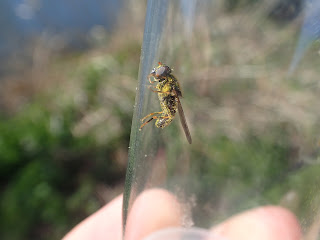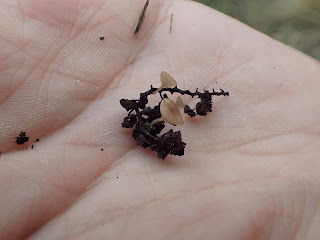18th March 2017
Saturday saw my first Norfolk Fungus Study Group foray of the year, at Barney Wood in North Norfolk. Barney Wood is a privately owned wood that makes up part of the Swanton Novers NNR, and was previously visited by the group in last autumn. We don't tend to visit the same sites in consecutive years, but only four members made last October's visit and they still managed to record over 100 species, so it was deemed worth a re-visit. This time we numbered 14, with two of these visitors from Lincolnshire, including Mark Joy who I had previously corresponded with via email.
Having met nearby, we combined into a smaller number of cars before continuing down to the site. Keith Fox gave us a brief introduction to the area before we set about looking for fungi. The first woodland clearing held some flowering Wood Anemone, and we checked for a scarce cup fungus that is associated with it, but without success. Anne spotted some Spring Hazelcup growing high in a tree - best seen with binoculars! I noticed some small orange fungi growing on Red Deer droppings - these have now been examined by Tony Leech and found to be Lasiobolus macrotrichus, a new species for Norfolk which is pleasing.


The first gilled species was found close by in an area of conifers, and aptly was Pine Cone Cap. The first of several specimens of the scarcer Trametes spp was also seen nearby - this one appeared to be Trametes hirsuta but was retained for checking. Tim was checking the dead wood for invertebrates, and we found a very long centipede and some non-native weevils, Euophryum confine. An area of clearfell held both Slender and Common Groundhoppers, Orange Ladybird and several species of ground beetle.
At the edge of the cleared area a stream ran through, and the boggy sides were covered with Opposite-leaved Golden Saxifrage. Scarlet Elf Cup grew nearby, as did Glistening Ink Cap. There were also several small cup fungi here, including some white Lachnum-types and some stalked ones that were probably Cudoniella. We stopped here for lunch before continuing into the woods.
The afternoon stretch of woodland had less clearly marked paths, and was punctuated by rain showers. Large areas of the woodland were covered in Wild Garlic leaves, complete with pungent aroma. Most of the fungi seen in here were growing on wood, the highlight being Peniophora limitata growing on Ash. As we made our way back to the entrance we saw old fruiting bodies of Shaggy Bracket and some fresher ones of Ganoderma applanatum and Trametes ochracea. Under a log we found a Buzzing Snail-hunter beetle, a frog and about 10 young Smooth Newts. Driving back to the main road a Hare ran across the track to complete the days wildlife.












































